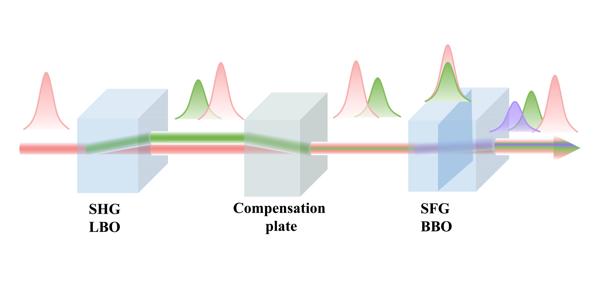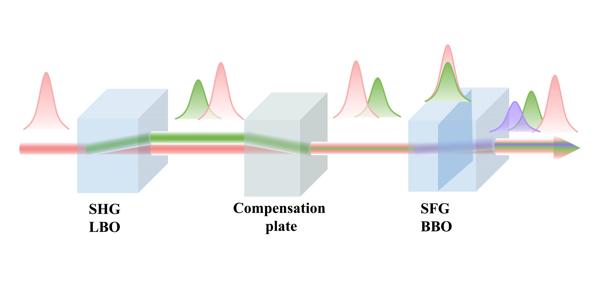The ultra-short laser sources, especially in ultraviolet (UV) region, are widely used for many different kinds of applications such as microfabrication, ultrafast spectroscopy, quantum optics, scientific research and so on. The UV pulses with high single-photon energy allows rapid absorption and a small focal spot, potentially enabling high machining accuracy and patterning ability even in wide bandgap materials.
At present, the nonlinear frequency up-conversion, especially the third harmonic generation (THG), of near-infrared ultra-short lasers is the prevalent technology to generate UV pulses. For the THG process, the most widely used method is collinear sum-frequency mixing (SFM) configuration, which works well for continuous wave or relative long laser pulse. However, this approach is not suitable for the TH generation in the femtosecond regime due to the extremely narrow pulses durations. The temporal walk-off effect caused by group velocity mismatch will reduce the overlap of three interacting waves, thus decrease the conversion efficiency. Traditionally, a delay line is used to control the temporal overlap of the unconverted pump and second harmonic (SH) beams after they are separated using a dichroic mirror. The most common drawbacks of such a delay line system lie in their bulky size and complicated system design. Besides, the separated and recombined beams is difficult to align and oversensitive to minor disturbances in the environment.
An alternative way to compensate the temporal walk-off effect is to introduce one or multiple compensation plates (CPs) with relative anomalous dispersion, which enables tabletop UV laser systems with compact configuration and low loss. The cascaded THG scheme with a CP can achieve high conversion efficiency. The CP can be used to reverse both the spatial and temporal walk-off due to its birefringence effect. In recent years, the CPs have been used in the THG of Ti:Sapphire lasers to achieve efficiency improvements compared to no CPs. However, the bulky design and high price of Ti:Sapphire lasers make them less competitive compared with fiber lasers. In particular, the rapid development of Yb-doped femtosecond fiber lasers has brought about a new generation of high-power, compact, stable, and cost effective laser sources for scientific research and industrial applications. Therefore, this compact, stable, and efficient femtosecond UV source based on femtosecond fiber lasers with compensation plates will benefit various practical applications.
The research group led by Prof. Minglie Hu from Tianjin University presented a cascaded THG scheme with CPs based on a home-made Yb-doped femtosecond fiber laser in Chinese Optics Letters, Volume 19, Issue 3, 2021 (M Zhang, et al., Efficient generation of third harmonics in Yb-doped femtosecond fiber laser via spatial and temporal walk-off compensation). The UV source at 345 nm based on Yb-doped femtosecond fiber laser with the CP provided output power >2 W at 1 MHz. This work is the first time to combine the advantages of the CP and the femtosecond fiber laser. The thickness and cutting angle of the CP are optimized to reverse both the spatial and temporal walk-off so that the fundamental and the SH pulses coincide in the SFG crystal.
To obtain optimum SFG efficiency, five kinds of CPs with different compensation capabilities were applied respectively. Each CP is distinguished for different delay times around the theoretical delay time induced by each component because the temporal walk-off dominates before SFG. By optimizing the parameters of the CP and incident light intensity, a maximum UV output of 2.23 W is obtained corresponding to a single-pass near-infrared-to-UV conversion efficiency as high as 23%. Over 1.78 times improvement of conversion efficiency is achieved comparing with the configuration without the CP. Moreover, compared with the traditional delay line, the CP achieved a higher power output and better power stability with a compact structure.
This work presented a compact, stable, and efficient femtosecond UV source based on femtosecond fiber lasers with CPs. The cascaded THG scheme with CPs will benefit various practical applications. Future work will focus on a systematic research of the heated nonlinear crystals by the CP method to obtain better beam quality and power stability.

Spatial and temporal walk-off effects and their optimization using a CP. Red, fundamental pulses; green, SH pulses; violet, UV pulses.

Experimental setup. λ/2, half-wave plate; TFP, thin-film polarizer; M1, plano mirror at 1030 nm; F1-F4, lenses; SHG, 3-mm LBO crystal; CP, compensation plate; DW, dual-wavelength waveplate; SFG, 3-mm BBO crystal; DM, dichroic mirror; M2, plano mirror at 345 nm.


